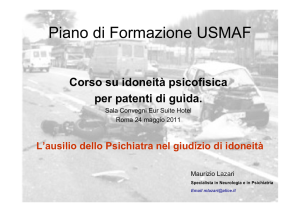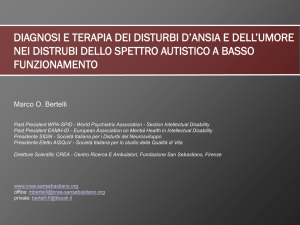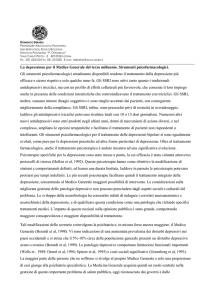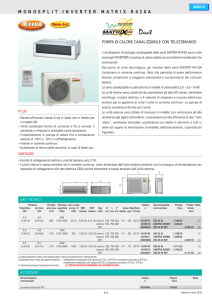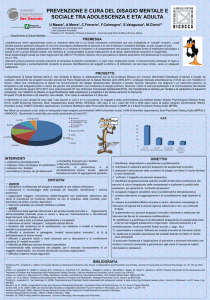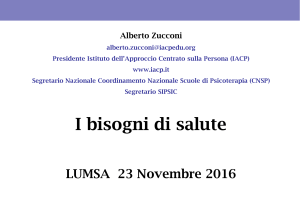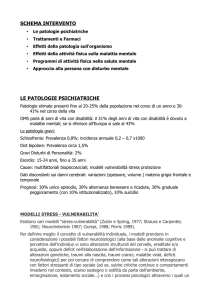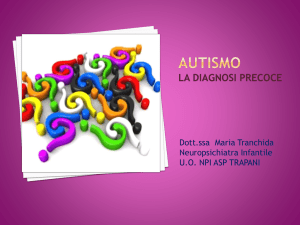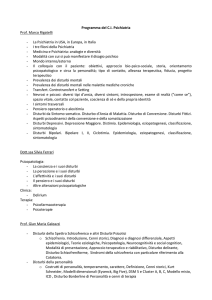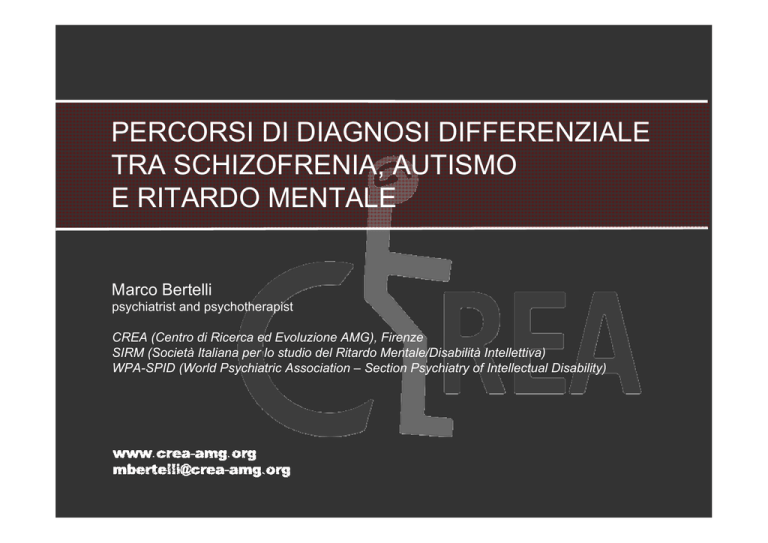
PERCORSI DI DIAGNOSI DIFFERENZIALE
TRA SCHIZOFRENIA, AUTISMO
E RITARDO MENTALE
Marco Bertelli
psychiatrist and psychotherapist
CREA (Centro di Ricerca ed Evoluzione AMG), Firenze
SIRM (Società Italiana per lo studio del Ritardo Mentale/Disabilità Intellettiva)
WPA-SPID (World Psychiatric Association – Section Psychiatry of Intellectual Disability)
Health & Science
Autism Epidemy: is it a Myth?
Jan. 22, 2007 | By Claudia Wallis
M. Bertelli, A. Hassiotis, S. Deb, L. Salvador-Carulla. New Contributions Of Psychiatric Research In The Field Of Intellectual Disability, WPA 2008
AUTISMO:
INTERESSE EPIDEMIOLOGICO CRESCENTE
60
50
40
30
n of studies
20
10
0
1999
2002
2009
Fombonne E. Epidemiology of pervasive developmental disorders. Pediatr Res. 2009 Jun;65(6):591-8.
INCREMENTO DEI TASSI DI PREVALENZA
DELL’AUTISMO E DEI DSA
■
Autism1
1. Newschaffer et al., 2007.
2. Lazoff et al., 2010; Baron‐Cohen et al., 2009
■
ASD2
AMPIEZZA DEI TASSI DI PREVALENZA (%)
DELLA SCHIZOFRENIA NELLA DI
Circa il 3% delle persone con Disabilità
Intellettiva potrebbe avere un disturbo
diagnosticabile come schizofrenia1-2.
Il 4,4% come disturbo dello spettro
schizofrenico3.
1. Turner, 1989
2. Hassiotis et al., 2001
3. Cooper et al., 2007b
AMPIEZZA DEI TASSI DI PREVALENZA (%)
DSA E DI
PDD nella DI = 30-40%1
DI nell’autismo = 25-80%2
nella DI circa il 50% dei DSA è stato
precedentemente diagnosticato come schizofrenia3
rischio di sottostima dei DSA nella DI a favore
della schizofrenia4
1. Kraijer 1997 (N=718); Morgan et al. 2002 (N=571); La Malfa et al., 2004 (N=166 adults); Cooper et al., 2007
2. Hoekstra et al., 2009 BJP; Centers for Disease Control and prevention USA, 2006; Edelson, 2006; Matson e Shoemaker, 2009;
Baird et al., 2006; Noterdaeme e Wriedt, 2010; Bryson and Smith, 1998
3. Bryson et al. Prevalence of autism among adolescents with intellectual disabilities. Canadian J of Psychiatry, 2008; 53(7): 449-59
4. Palucka et al., 2009; Savage et al., 2007
AMPIEZZA DEI TASSI DI PREVALENZA (%)
DSA E SCHIZOFRENIA
21% delle persone con schizofrenia riceve una
diagnosi lifetime di DSA-NAS1
circa il 50 % delle persone con autismo soddisfa
anche i criteri per schizofrenia tipo disorganizzato2
almeno l’1,5% dei pazienti psichiatrici
ambulatoriali non riceve la corretta diagnosi di
DSA, il 26% di questi riceve una diagnosi di
schizofrenia3
1. Sporn et al., 2004; Towbin et al., 2005
2. Konstantareas and Hewitt, 2001
3. Nylander and Gilberg, 2001
PREVALENZA DEI DP NEI DSI
• La prevalenza di Disturbi Psichiatrici nelle persone con DSI varia dal 10 al 46%
Cooper 20072
Clinical D
% 40,9*
Deb 20013
PAS-ADD
Deb 20013
ICD-10
Cooper 19974
ICD-10 DCR
Cooper 19974
PPS-LD
Meltzer 19955
ICD-10
BorthwickDuffy6
1990 DSM-III
Reiss 19907
Reiss Screen
Lund 19858 Corbett 19799
DSM-III
ICD-8
22,2
14,4
23,4
43,8
16,1
10,1
39,4
28,2
46,1
* = escluse le fobie specifiche
Tassi di Point Prevalence2
Clinica
Clinica
Clinica
(senza CP)
DC-LD
ICD-10 DCR
DSM-IV TR
% 22,4
37,0
28,3
19,1
14,5
13,9
(senza DSA e CP)
(senza DSA)
• Il tasso di prevalenza è di gran lunga più alto della schizofrenia o del disturbo bipolare
1. Borthwick-Duffy SA. Epidemiology and prevalence of psychopathology in people with mental retardation. J Cons Clin Psy, 1994; 62: 17-27
2. Cooper SA., Smiley E., Morrison J., et al. Mental ill-health in adults with intellectual disabilities: prevalence and associated factors. British J Psy 2007; 190: 27-35.
3. Deb S., Thomas M., and Bright C. Mental disorder in adults with intellectual disability. I: prevalence of functional psychiatric illness among a community-based
population aged between 16 and 64 years. J Intell Dis Res, 2001; 6: 495-505
4. Cooper, S.-A. Psychiatry of elderly compared to younger adults with intellectual disability. J of Appl Res in Intellectual Disability 1997, 10 (4): 303–311.
5. Meltzer, H., Gill, B., Petticrew, M. & Hinds, K. (1995) The prevalence of psychiatric morbidity among adults living in private households: OPCS survey of
psychiatric morbidity in Great Britain, report 1. London: HMSO.
6. Borthwick-Duffy, S. A. & Eyman, R. K. (1990) Who are the dually diagnosed? American Journal of Mental Retardation 94 586–595.
7. Reiss, S. Prevalence of dual diagnosis in community-based day programs in the Chicago metropolitan area. Am J Mental Ret 1990, 94: 578–585.
8. Lund, J. The prevalence of psychiatric morbidity in mentally retarded adults. Acta Psychiatrica Scandinavica 1985, 72: 563–570.
9. Corbett, J. A. (1979) Psychiatric morbidity and mental retardation. In: F. E. James and R. P. Snaith (Eds) Psychiatric Illness and Mental Handicap pp11–25.
London: Gaskell Press.
AMPIEZZA DEI TASSI DI PREVALENZA (%)
DEI DISTURBI PSICHIATRICI PER GRAVITÀ
Mild
Moderate
Cooper 20071
25,4
Borthwick-Duffy & Eyman 19902
16,1
9,2
Iverson & Fox 19893
55,1
32,2
Göstason 19854
Severe
Profound
30,2
33,2
5,2
6,1
26,2
37,4
1. Cooper SA., Smiley E., Morrison J., et al. Mental ill-health in adults with intellectual disabilities: prevalence and associated factors. British J Psy 2007; 190: 27-35.
2. Borthwick-Duffy SA. Epidemiology and prevalence of psychopathology in people with mental retardation. J Cons Clin Psy, 1994; 62: 17-27.
3. Iverson JC., Fox RA. Prevalence of psychopathology among mentally retarded adults. Research in Developmental Disabilities, 1989; 10: 77-83.
4. Göstason R. Psychiatric illness among the mentally retarded: a Swedish population study. Acta Psychiatrica Scandinavica, 1985; 7(318): 1-117.
AMPIEZZA DEI TASSI DI PREVALENZA (%)
DEI DISTURBI PSICHIATRICI SPECIFICI NELLA DI
Cooper 20071 Deb 20012
Cooper &
Bailey 20013
Lund
19854
Corbett 19795
Psychotic Disorder 4,4
5,6
2,7
1,3
6,2
Affective Disorder
6,6
2,2 (5,5 PAS-ADD)
6,0
1,7
6,0
Anxiety Disorder
4,5
6,6 (8,9 PAS-ADD)
7,2
2,0
combined
Autistic-spectrum
7,5
-
6,8
3,6
8,2
1. Cooper SA., Smiley E., Morrison J., et al. Mental ill-health in adults with intellectual disabilities: prevalence and associated factors. British J Psy 2007; 190: 27-35.
2. Deb S., Thomas M., and Bright C. Mental disorder in adults with intellectual disability. I: prevalence of functional psychiatric illness among a community-based
population aged between 16 and 64 years. J Intell Dis Res, 2001; 6: 495-505
3. Cooper SA., Bailey NM. Psychiatric disorders amongst adults with intellectual disability: prevalence and relationship to ability level. Irish J Psych Med, 2001; 18:
45-53
4. Lund, J. The prevalence of psychiatric morbidity in mentally retarded adults. Acta Psychiatrica Scandinavica, 1985; 72: 563–570.
5. Corbett, J. A. (1979) Psychiatric morbidity and mental retardation. In: F. E. James and R. P. Snaith (Eds) Psychiatric Illness and Mental Handicap pp11–25.
London: Gaskell Press.
AMPIEZZA DEI TASSI DI PREVALENZA (%)
DEI DISTURBI PSICHIATRICI SPECIFICI PER LIVELLO DI DI
Mild
Moderate
Severe
Psychotic Disorder
5,8
3,5
Affective Disorder
6,5
6,7
Anxiety Disorder
6,0
2,4
Autistic-spectrum
3,5
10,1
Profound
Cooper SA., Smiley E., Morrison J., et al. Mental ill-health in adults with intellectual disabilities: prevalence and associated factors. British J Psy
2007; 190: 27-35.
AMPIEZZA DEI TASSI DI PREVALENZA (%)
DEI DISTURBI PSICHIATRICI NEI DSI CON E SENZA AUTISMO
Prevalenza
DSI senza A
Strum.
DSI con A
Bradley & Bolton, 2006
SAPPA
50
DASH
>50
16,7
Bradley et al., 2004
Depressione
25
50
8
Mania
67
8
DCA
58
25
Bradley E.A.
and Bolton P. Episodic psychiatric disorders in teenagers with learning disabilities with and without autism.
Schizofrenia
8 British Journal of
Psychiatry, 2006, 189: 361-366
Bradley E.A., Summers J.A., Wood H.L., Bryson S.E. Comparing rates of psychiatric and behavior disorders in adolescents and young adults
8 J of Autism and Developmental Disorders, 2004; 34(2): 151-161
with severe intellectual disability with and without autism.
ETÀ D’ESORDIO DEI DP NEI DSI
45% dei soggetti fra i 4 ed i 18 anni1
1-3 episodi entro i 19 anni
(1-6 se co-presente autismo)2
S. L. Einfeld and B. J. Tonge. Population prevalence of psychopathology in children and adolescents with intellectual disability: II
epidemiological findings. Journal of Intellectual Disability Research, 1996; 40(2): 99-109
Bradley E. and Bolton P. Episodic psychiatric disorders in teenagers with learning disabilities with and without autism. British Journal of
Psychiatry (2006), 18 9, 361-366.
DIAGNOSI PSICHIATRICA NEI DSI: PRINCIPALI PROBLEMI
definizione di Disturbo dello Sviluppo Intellettivo
definizione di Disturbo Mentale/Psichico
natura della Valutazione Psichiatrica
rappresentatività dei Campioni degli studi
uso di Criteri Diagnostici appropriati
classificazione dei Comportamenti Problema
Costello H. and Bouras N. Assessment of mental health problems in people with intellectual disabilies. Isr J Psychiatry Relat Sci Vol 43 No. 4 (2006): 241-251
Smiley E. Epidemiology of mental health problems in adults with learning disability: an update. Advances in Psychiatric Treatment, 2005; 11: 214-222
DEFINIZIONE DI DISTURBO MENTALE NEI DSI
manca accordo su quali problemi di salute mentale dovrebbero venir inclusi1
molte concettualizzazioni diverse sia della DI che della salute mentale,
evidenti nella letteratura1
difficoltà nella determinazione della compromissione del funzionamento
•
PcDSI hanno disadattamento ed aspettative di ruolo più basse: i sintomi
possono esser meno legati al grado di compromissione della vita quotidiana2
difficoltà nella determinazione del distress clinicamente significativo
•
PcDSI sono costantemente esposte a molti stressori e presentano maggiore
vulnerabilità: i sintomi possono esser meno legati al grado di distress nella vita
quotidiana2
1. Holland A, Koot HM. Mental health and intellectual disability: An international perspective. J Intellect Disabil Res 1998; 42:505–512.
2. Costello H. and Bouras N. Assessment of mental health problems in people with intellectual disabilies. Isr J Psychiatry Relat Sci Vol 43 No. 4 (2006): 241-251
3. Bertelli et al., GIP, 2010
DIFFICULTÀ DEL PROCESSO DIAGNOSTICO NEI DSI
ciò che la persona dice di esperire
• difficoltà nelle capacità di comunicazione o mancanza di linguaggio;
• anche nei verbalmente competenti possono sussistere difficoltà a
descrivere le esperienze soggettive.
• Le allucinazioni uditive sono risultate il solo sintomo di primo rango
rilevabile.
ciò che gli altri dicono di lei e di come si comporta
• un fattore confondente è la credenza che questi problemi siano
inevitabili e immodificabili. Questo si traduce nella mancata richiesta di
valutazione psichiatrica.
la presentazione dei sintomi
Costello H. and Bouras N. Assessment of mental health problems in people with intellectual disabilies. Isr J Psychiatry Relat Sci Vol 43 No. 4 (2006): 241-251
Mental health and intellectual disabilities addressing the mental health needs of people with id. Report by the Mental Health Special Interest Research
Group of the IASSID to the World Health Organisation. Final version – September, 2001
Reiss S, Syszko J. Diagnostic overshadowing and professional experience with mentally retarded persons. Am J Ment Deficiency 1993; 87:396–402.
Konstantareas MM. and Hewitt T. Autistic disorder and schizophrenia: diagnostic overlaps. Journal of Autism and Developmental Disorders, 2001; 31(1): 19-28
PECULIARITÀ DEL PROCESSO DIAGNOSTICO
storia di sofferenza
• per esempio lo sviluppo di comportamenti disadattivi, ritiro ingravescente
o cambiamenti dei pattern abitualmente associati al benessere individuale
possono
essere un marker di un possibile problema di salute mentale
(‘baseline exaggeration’, ‘deviazione dal livello di base’);
•stabilire il livello di base (osservazione dei repertori comportamentali
ricorrenti) e registrare i cambiamenti sono momenti centrali nel processo
diagnostico (psichiatri on site e super-specializzati*)
sintomatologia somatica
•(dolori, disfunzioni d’organo o d’apparato, cambiamenti dei ritmi
circadiani, distonie del sistema nervoso autonomo), che rimanda
all’esistenza di una particolare vulnerabilità neurovegetativa.
Costello H. and Bouras N. Assessment of mental health problems in people with intellectual disabilies. Isr J Psychiatry Relat Sci Vol 43 No. 4 (2006): 241-251
Mental health and intellectual disabilities addressing the mental health needs of people with id. Report by the Mental Health Special Interest Research
Group of the IASSID to the World Health Organisation. Final version – September, 2001
*Hurley et al., 2003; Lunsky et al., 2008; 2009; Lennox and Edwards, 2004
FORMAZIONE SUPERSPECIALISTICA E DIAGNOSI
Gli psichiatri con una formazione specifica per la DI
tendono a fare più diagnosi di disturbi dell’umore,
disturbi d’ansia e disturbi dello spettro autistico e
meno diagnosi di disturbo psicotico rispetto ai
colleghi senza formazione specifica.
Hurley et al., 2003; Lunsky et al., 2008; 2009
COMPLESSITÀ DELLA FENOMENOLOGIA
DEI DISTURBI PSICHIATRICI NEI DSI
distorsione intellettiva1
livello di funzionamento cognitivo, comunicativo, fisico e sociale
appropriatezza evolutiva2
livello di sviluppo individuale
mascheramento psicosociale3
influenze interpersonali, culturali e ambientali
sovraombratura diagnostica4
Differenziare fra sintomi psichiatrici e segni e sintomi del
disfunzionamento cognitivo di base
1. Sovner R, DesNoyers Hurley A. Four factors affecting the diagnosis of psychiatric disorders in mentally retarded persons. Psychiatric Aspects of Mental
Retardation Reviews 1986; 5: 45–48.
2. Cooper SA., Salvador-Carulla L. (2009) Intellectual Disabilities. in I.M. Salloum and J.E. Mezzich Eds. Psychiatric Diagnosis: Challenges and Prospects. John
Wiley & Sons, Ltd
3. Sovner R. Limiting factors in the use of DSM-III criteria with mentally ill/ mentally retarded persons. Psychopharmacol Bull 1986; 24:1055–1059.
4. Reiss S, Syszko J. Diagnostic overshadowing and professional experience with mentally retarded persons. Am J Ment Deficiency 1993;87:396–402.
COMPLESSITÀ DELLA FENOMENOLOGIA
DEI DISTURBI PSICHIATRICI NEI DSI - 2a
presentazione atipica o mascherata1
aggressività, urla, comportamenti disadattivi, ecc.
vulnerabilità neurovegetativa
sintomi somatici, cambiamenti del ritmo circadiano, distonie NV
disintegrazione cognitiva2
compromissione dei meccanismi di coping e soglia di resistenza agli
stressori più bassa
1. Cooper SA., Salvador-Carulla L. (2009) Intellectual Disabilities. in I.M. Salloum and J.E. Mezzich Eds. Psychiatric Diagnosis: Challenges and Prospects. John
Wiley & Sons, Ltd
2. Sovner R. Limiting factors in the use of DSM-III criteria with mentally ill/ mentally retarded persons. Psychopharmacol Bull 1986; 24:1055–1059.
CRITERI CRONOLOGICI E RAGGRUPPAMENTI PER LA
DIAGNOSI PSICHIATRICA NEI DSI
difficoltà nell’applicazione dei criteri cronologici e nell’individuazione
dei sintomi per la sottocategorizzazione
mancanza di dati sull’uso dei criteri diagnostici nei sottotipi, soprattutto
nei gradi grave e gravissimo (p.e. DC-LD Non-affective psychotic
disorders)
mancanza di dati sul valore prognostico dei criteri cronologici
impatto di questi ed altri limiti sull’accesso ai servizi di salute
mentale
elevata morbilità psichiatrica nascosta, anche in setting di qualità
elevata con supporto psicologico
adozione di un approccio basato sul problema invece che strettamente
diagnostico
team multidisciplinari, che seguono un approccio bio-psico-sociale
1. Royal College of Psychiatrists. Diagnostic Criteria for Psychiatric Disorders for Use with Adults with Learning Disabilities/Mental Retardation
(DC-LD). Gaskell: Londra; 2001.
1. Salvador-Carulla L, Rodrıguez-Blazquez C, RodrıguezdeMolina M, et al. Hidden psychiatric morbidity in a vocational programme for
people with intellectual disability. Journal of Intellectual Disability Research 2000;44: pp. 147–154.
2. Costello H. and Bouras N. Assessment of mental health problems in people with intellectual disabilies. Isr J Psychiatry Relat Sci Vol 43 No. 4
(2006): 241-251
SINTOMI SIMIL-PSICOTICI NEI DSI E DSA
Parlare da soli
Amici immaginari
Interpretazioni e spiegazioni desuete
Regressione
Posture particolari
O’Dwyer J.M. Autistic disorder and schizophrenia: similarities and differences and their coexistence in two cases. Mental Health Aspects
of Developmental Disabilities, 2000; 3(4): 121-31.
Hurley A.D., Folstein M., and Lam N. Patients with and without intellectual disability seeking outpatient psychiatric services: diagnoses
and prescribing pattern. Journal of Intellectual Disability Research, 2003; 47(1): 39-50.
SINTOMI SIMIL-SCHIZOFRENICI NEI DSI E DSA
Parlare da soli
Amici immaginari
Interpretazioni e spiegazioni desuete
Regressione
Posture particolari
Aggressività da trauma, abuso o deprivazione emotiva
shut down states (autism and anxiety)
catatonia (autism)
O’Dwyer J.M. Autistic disorder and schizophrenia: similarities and differences and their coexistence in two cases. Mental Health Aspects
of Developmental Disabilities, 2000; 3(4): 121-31.
Hurley A.D., Folstein M., and Lam N. Patients with and without intellectual disability seeking outpatient psychiatric services: diagnoses
and prescribing pattern. Journal of Intellectual Disability Research, 2003; 47(1): 39-50.
Hubert J, and Hollins S. Men with severe learning disabilities and challenging behaviour in long-stay hospital care: qualitative study. The
British Journal of Psychiatry , 2006; 188:70-74.
Loos HG. And Loss Miller IM. Shutdown states and stress instability in autism. Avalilable at www.cuewave.com/tau/SI-SDinautism.pdf (11
Dec 2009)
Shah A. and Wing L. sychological approaches to chronic catatonia-like deterioration in autism spectrum disorders. International Review
of Neurobiology, 2006; 72: 245-64.
FENOMENOLOGIA DEI SINTOMI PSICHIATRICI NEI DSI:
POSSIBILI SINTOMI DI SCHIZOFRENIA
resta in posizione di ascolto e/o risponde a suoni o voci non udibili
indirizza lo sguardo verso zone dove non ci sono oggetti da vedere e/o
fissa ripetutamente lo sguardo
mostra una tendenza eccessiva ad identificarsi con persone o oggetti
attribuisce arbitrariamente nessi di causa-effetto con autoreferenzialità
ha difficoltà a concludere sequenze di azioni, mostra comportamento
disorganizzato o si esprime in modo disorganizzato o incoerente
mostra atteggiamenti di diffidenza nei confronti degli altri e/o
comportamenti sostenuti da ostilità ingiustificata
FENOMENOLOGIA DEI SINTOMI PSICHIATRICI NEI DSI:
OVERSHADOWING NELLA SCHIZOFRENIA
importante distinguere sempre tra sintomi simil-psicotici e sintomi psicotici veri
il contenuto patologico del pensiero può essere anche molto semplice
alcuni tipi di ‘pensiero fantastico’ possono far parte della sintomatologia di un
disturbo dello spettro autistico
la diagnosi di schizofrenia non può esser fatta soltanto sulla base di segni
indiretti di allucinazione
compromissioni del sensorio sono frequenti nelle persone con DI e possono
rappresentare una causa o un fattore precipitante
le persone con DI possono avere difficoltà a riconoscere i pensieri propri e
tendere ad attribuirli ad altri, questo atteggiamento non può essere interpretato
come interferenza del pensiero
le persone disabili possono avere la sensazione di essere controllate dagli altri
perché spesso lo sono effettivamente
con le persone con cui sia possibile il colloquio, considerare sempre
tendenza all’acquiescenza
la
SINTOMI USATI DAI CLINICI PER
DISTINGUERE AUTISMO E SCHIZO NEI DSI
254 item da un pool di strumenti (PAS-ADD, DASH, ABC, K-SADS, PANSS, ecc)
184 item considerati riferiti a sintomi core
•72 (39%) autismo
•43 (23%) psicosi
Helverschou S.B., Bakken T.L., and Martinsen H. Identifying symptoms of psychiatric disorders in people with autism and intellectual
disability: an empirical conceptual analysis. Mental Health Aspects of Developmental Disabilities, 2008
ITEM PSICOSI-SPECIFICI NEI DSI
N=16
Derail within conversation or task
Unexpected attacks Violent behavior Hallucinatory behavior
Suspected hallucinations
Gross disorientation Delusions
Threatening behavior Rapid mood fluctuations Auditory hallucinations
Less initiative -Gross disorientation in known areas
Gross disorientation within social interaction
Aroused mood
High motor activity High communicative activity Helverschou S.B., Bakken T.L., and Martinsen H. Identifying symptoms of psychiatric disorders in people with autism and intellectual
disability: an empirical conceptual analysis. Mental Health Aspects of Developmental Disabilities, 2008
AUTISMO E SCHIZOFRENIA:
COME DISTINGUERE
Età d’esordio
DSI dai primi atti fisiologici
autismo prima dei 3 aa
schizofrenia (anche infantile) mai prima dei 6-8 aa
Valutazione estensiva (sia qualitativa che quantitativa)
Valutazione preliminare del livello di base
Approccio rigoroso e sistematico
(p.e. DC-LD, DM-ID, SPAID)
Conoscenza specifica della fenomenologia psichiatrica
nei DSI
SPAID-DPS
GENETIC OVERLAPPING BETWEEN AUTISM AND IDD
Gene:
Protein:
• FMR1 Xq27.32
• neuroligina3
• GRIK2 6q16.32
• neurexina3
• HOXA1 7p15.32
• SHANK-33
• PTCHD11
• CNTNAP24
• NLGN4 and IL1RAPL12
• PUM25 implications in mRNA
• RPL102
• CGG trinucleotide6
deletion
• 1q21.12
LTD on mGluR7
• 15q13.32
• 16p11.22
1Noor A, Scherer SW. Disruption at the PTCHD1 locus on Xp22.11 in autism spectrum disorder and intellectual disability. Sci Transl Med. 2010 September 15; 2(49)
2Pinto D, Scherer SW. Functional Impact of Global Rare Copy Number Variation in Autism Spectrum Disorder Nature. 2010 July 15; 466(7304): 368–372. doi:10.1038/nature09146
3Bakkaloglu B, et al. Molecular cytogenetic analysis and resequencing of contactin associated protein-like 2 in autism spectrum disorders. Am J Hum Genet. 2008 Jan;82(1):165-73.
4Alarcón M, et al. Linkage, association, and gene-expression analyses identify CNTNAP2 as an autism-susceptibility gene. Am J Hum Genet. 2008 Jan;82(1):150-9
5Vessey J.P., Schoderboeck L., Gingl E., Luzi E, et al. Mammalian Pumilio 2 regulates dendrite morphogenesis and synaptic function. PNAS ( Proceedings of the National Academy of
Sciences). Published online before print January 28, 2010
6Gabis LV, Baruch YK, Jokel A, Raz R. Psychiatric and autistic comorbidity in fragile x syndrome across ages. J Child Neurol. 2011 Aug;26(8):940
7Lüscher C, Huber KM. Group 1 mGluR-dependent synaptic long-term depression: mechanisms and implications for circuitry and disease. Neuron. 2010 Feb 25;65(4):445-59
GENETIC OVERLAPPING
BETWEEN AUTISM AND SCHIZOPHRENIA
Chromosome 1q21.1 deletion 1
Chromosome 15q13.3 deletion 1
Chromosome 3q29 and 22q11.21 deletion
Chromosome 16p11.2 duplication 1
exonic NRXN1 deletion 1
exonic VIPR2 and C16orf72 duplication 1
Chromosome 16p11.22
NRXN1 2p16.3 gene disrupted in ASD, MR, schizophrenia4
16p13.11 deletion
Deficits in RNA transcription without changes in DNA sequence5-6
1. Levinson DF, Gejman PV. Copy Number Variants in Schizophrenia: Confirmation of Five Previous Findings and New Evidence for 3q29 Microdeletions and VIPR2 Duplications. Am J
Psychiatry. 2011 Mar;168(3):302-16
2. McCarthy SE, Sebat J. Microduplications of 16p11.2 are associated with schizophrenia. 2009 Nov;41(11):1223-7
3. Akbarian S, Huang HS. Epigenetic regulation in human brain-focus on histone lysine methylation. Biol Psychiatry, 2009 Feb 1;65(3):198-203; Singh SM, O'Reilly R. (Epi)genomics and
neurodevelopment in schizophrenia: monozygotic twins discordant for schizophrenia augment the search for disease-related (epi)genomic alterations. Genome, 2009 Jan;52(1):8-19
4. Pinto D, Scherer SW. Functional Impact of Global Rare Copy Number Variation in Autism Spectrum Disorder Nature. 2010 July 15; 466(7304): 368–372. doi:10.1038/nature09146
5. Akbarian S, Huang HS. Epigenetic regulation in human brain-focus on histone lysine methylation. Biol Psychiatry, 2009 Feb 1;65(3):198-203
6. Singh SM, O'Reilly R. (Epi)genomics and neurodevelopment in schizophrenia: monozygotic twins discordant for schizophrenia augment the search for disease-related (epi)genomic
alterations. Genome, 2009 Jan;52(1):8-19
GENETICS OF NEURODEVELOPMENTAL DISORDERS
RELN
Reelin1
synaptic function
Neuronal migration and
Npas4G
functions
Npas42
Social and cognitive
1q21.1
regulation
CHD1 e PBKAB2
chromatine and AMP kinase
16p11.2
16p13.1
GRIN2
NMDA rec
perceptual binding
working memory and
TCF4
NRXN1
1. Folsom et al. Neuropharmacology, 2012; 2. Coutallier et al. PLos One, 2012; 3. Crespi et al. J Neurodev Disord, 2012; Endele et al. Nat Genet, 2010 ;
Hennekam et al. Dev Med Child Neurol, 2012
CNTNAP2
contactin-L2
cell adhesion and receptors
METACATEGORY AND NAME
INTELLECTUAL
DEVELOPMENTAL
DISORDERS
(IDD)
F7
Salvador-Carulla L.. Reed G., Bertelli M. et al, World Psychiatry, in press
F1
SCFs AND NOT IQ
FOR BIOLOGICAL SUBSTRATES
Findings of recent studies of genetics, neuroimaging and
neurophysiology identified more correlations with
cognitive functions (such as perceptual organization
deficit, poor working memory, lexical, visual-spatial and
phonological processing) than with IQ scores1,2,3,4,5,6
1. Steinlin M. (2008). Cerebellar disorders in childhood: cognitive problems. Cerebellum. 7:607-10; 2.Tavano A., Borgatti R. (2010). Evidence for a link among
cognition, language and emotion in cerebellar malformations. Cortex. 46:907-18; 3.Ardila A., Pineda D., Rosselli M. (2000). Correlation between intelligence test
scores and executive function measures. Archives of Clinical Neuropsychology. 15:31-6; 4.Friedman N.P., Miyake A., Corley R.P., Young S.E., Defries J.C.,
Hewitt J.K. (2006). Not all executive functions are related to intelligence. Psychological Science. 17:172-9; 5.Johnson W., Jung R.E., Colom R., Haier R.J.
(2008). Cognitive abilities independent of IQ correlate with regional brain structure. Intelligence. 36:18-28; 6.Mackintosh NJ. (1999). IQ and Human Intelligence.
Reviewed by Robert Plomin. The American Journal of Human Genetics. 65:1476-1477.
IQ AND COGNITIVE PROFILE IN GS
Syndrome
ID level
Specific Cognitive Dysfunction
Down
Mild, moderate or severe
visual and perceptive skills,
planning, problem solving,
visuo-spatial working memory,
verbal working memory, set
shifting,
Language, short-term and
long-term memory
X Fragile
15% mild
49% moderate
26% severe
10% profound
Expressive language, reasoning
speed processing, social
cognitive skills (facial
expression recognizing),
learning of espressiveness,
shifting,verbal short-term-memory, visuospatial functions
Williams
7q delection
Mild or moderate
Learning, language, attention
communication, planning,
rigidity, visual-spatial memory,
visual spatial abilities,
long term memory,
short term memory
Smith-Magenis
(17p delection)
Mild or moderate
impulsivity, distractibility,
inattention, sensory integration,
sequential processing,
short term memory
Bertelli et al. (2011). PSICOGEN (PSIchyatric disorders and Cognition in GENetic syndromes).In submission.
IQ AND COGNITIVE PROFILE IN GS - 2
Syndrome
ID level
Specific Cognitive Dysfunction
Warkany 2
(trisomy 8)
moderate or severe
Language, memory, attention, visualmotor skills, emotional control
Phenylketonuria
moderate or severe
Temporal organization,
sequential thought,
problem solving,
working memory,
attention, planning,
visual-spatial skills
Klinefelter
(47 XXY)
absent or borderline
Language, learning of
language skills
Galctosemia
absent or borderline
language disorders
(expressive and receptive)
verbal dyspraxia
visual perception, maths
deficits, recall
Bertelli et al. (2011). PSICOGEN (PSIchyatric disorders and Cognition in GENetic syndromes).In submission.
WAIS IV SUBTESTS AND SUBSCORES
Copyright © 2008 Pearson Education, Inc. or its affiliate(s). All rights reserved.
Marco Bertelli
psichiatra, psicoterapeuta
SIRM - Società Italiana per lo studio del Ritardo Mentale (Sezione Speciale SIP)
WPA-SPID – Associazione mondiale di Psichiatria - Sezione Disabilità Intellettiva
EAMH-ID – Associazione Europea per la Salute Mentale nella Disabilità Intellettiva
CREA - AMG Research and Evolution Centre, Firenze (Italy)
CONTACT DETAILS:
[email protected]
[email protected]

